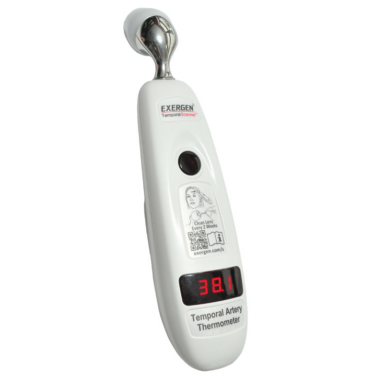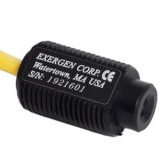Exergen has developed an highly advanced and innovative way of taking a patient’s temperature using non-invasive infrared technology that is highly beneficial for productivity.
Let’s take a moment to consider this question before diving into innovations in clinical thermometry: do thermometers that measure the blood temperature in the temporal artery have anything to do with the design of energy-saving methods for a well-known university’s central heating system?
In short, yes. It is because both were developed by Dr Francesco Pompei.
Heaters and infrared thermometers
Dr. Pompei is the founder and CEO of Exergen. He holds BS and MS degrees from MIT, as well as SM and Ph.D. degrees from Harvard. Having started his first business at age 31, Dr. Pompei was asked by Harvard University to provide new energy-saving methods to respond to the huge rise in energy costs in the early 1980s. Through his research into the behavior of air and water in pipes, Harvard was able to reduce its energy costs dramatically for heating and cooling all of its buildings and laboratories.
However, in order to design energy saving programs that were certain to work, Dr. Pompei needed very accurate heat and temperature data. In order to accomplish this, he developed highly sophisticated infrared sensors. With the intention of utilizing this new technology in products, he published these findings as patents. The company he founded – Exergen – began selling infrared scanners that are small and highly accurate, yet inexpensive as well. The success of Exergen began with these products.
Exergen’s new industrial scanners sparked an interest in accurate and non-invasive methods of measuring body temperature from the medical community as well. Dr. Pompei launched a major research program on thermoregulation and body temperature measurement. Dr. Pompei was also accepted into a Harvard Ph.D. program despite having no formal training in medical science, so he could learn what he needed to change how the world takes temperature. In his Ph.D., Dr. Pompei discovered new medical science that allowed him to invent an entirely new method of accurate and non-invasive body temperature measurement, the Temporal Artery Thermometer, which became the most successful product in Exergen’s history and the most successful thermometer in history.
Two important clinical questions
There is no doubt that fever is one of the oldest signs of disease. Study, description, and interpretation of this phenomenon date back to the earliest manifestations of civilization. Today, no common criteria exist for defining the border of febrile temperature and its clinical management. Domestic diagnosis and self-management of mild diseases associated with fever are so common that we take over-the-counter medications, such as paracetamol or ibuprofen, on a daily basis.
However, a fever in a hospital environment is a different matter, since it may indicate far more serious health issues. Nosocomial infections (hospital acquired infections) are severe, difficult to treat, and difficult to overcome. Thermometry is therefore crucial for early detection and treatment of these illnesses and co-morbidities.
Thermometry aims to answer two clinical questions:
– Does the patient have a fever, yes or no?
– And if the patient has fever, can we quantify it to let us know how severe it is?
Ultimately, we need to take a clinical decision, to treat or not and how. Therefore, the thermometer we want to use in a clinical setting should be fast, because we want to determine as quickly as possible if there is a fever, and accurate, because doctors and nurses need accurate data to determine the best possible treatment.
How do Temporal Artery Thermometer help you answer these two clinical questions?
The technology behind temporal artery thermometry
Exergen’s Temporal Artery Thermometers measure the temperature of the blood in the temporal artery on the forehead. The forehead artery is a perfect location for measuring the body temperature. Here is why. First of all, the temporal artery is located just 2 millimeters below the skin on the forehead. With the use of infrared technology, this is ideal for measuring blood temperature. Secondly, blood flowing through the temporal artery was just seconds before in the heart, which is the theoretically ideal spot to measure a person’s core body temperature. Temperature measurement is not affected by this time period between the blood being in the heart and flowing through the temporal artery.
Even though the forehead artery is already an ideal location for measuring blood temperature, more is needed to get highly accurate results. We needed to make sure the measurements of the Exergen Temporal Artery Thermometers are not impacted by outside influences. This is crucial because hospital-grade thermometers like Exergen’s Temporal Artery Thermometers are often used in different clinical settings, such as ICUs, general wards, as well as schools and nursing homes. As an example, if a student at a school is feeling poorly, but was outside in the heat or rain just before, we need to compensate for these outside influences. For this purpose Exergen has developed highly innovative algorithms.
Non-invasive and highly easy to use
This is how temporal artery thermometers work. An Exergen Thermometer measures the blood temperature 1000 times per second. Temperatures are recorded based on the highest found temperature (not the average temperature). In addition, Temporal Artery Thermometers measure the skin temperature above the temporal artery. Dr. Pompei’s algorithms compensate for the temperature found on the skin. All this is done in this 2-3 seconds time frame.
While the technology behind the Exergen Temporal Artery Thermometer is highly advanced and innovative, taking a person’s temperature with one is actually very simple. Using the thermometer to measure body temperature only requires a gentle swipe across the forehead to the side and a touch behind the earlobe. In just 2-3 seconds, this procedure produces a highly accurate measurement of the body temperature. This measurement is on par with rectal measurements and often more accurate than tympanic measurements.
Fast and accurate
Let’s go back to the two clinical questions we asked before: does the patient have a fever, and if so, can we accurately measure their body temperature as quickly as possible?
With Exergen’s Temporal Artery Thermometers, speed is a major benefit. From the moment the thermometer is picked up until it shows the exact temperature of the person, the procedure takes just seconds. An important feature of the Exergen Temporal Artery Thermometer is that it is non-invasive. Therefore, patients will not feel intimidated by the thermometer. This is especially true when it comes to very young patients, such as children. Furthermore, Exergen’s Temporal Artery Thermometers can be used to measure a patient’s temperature even when they are asleep.
Temporal Artery Thermometers provide a highly accurate measurement of body temperature in a short amount of time, which is very beneficial when it comes to nurse productivity. This also gives them more time to interact with patients. The accuracy of the Exergen Temporal Artery Thermometer is supported by over 100 peer-reviewed clinical studies.
Two hospital-grade thermometers
Exergen’s family of Temporal Artery Thermometers for use in professional clinical settings consists of two models:
TAT-5000S-EC
TAT-2000-EC
The TAT-5000S-EC easily stands up to the heavy duty demands of a high-performance hospital workplace, including intensive care units and emergency departments. Depending on patient care requirements, this model allows the choice of using disposable covers, or cleaning between patients with a disinfectant wipe, providing the means for significant cost savings by eliminating or substantially reducing probe cover usage.
The TAT-2000 is a light-duty professional model intended for school nurses, nursing homes, businesses and other occasional use clinical settings. It allows the choice of using disposable covers, or cleaning between patients with a disinfectant wipe.
These are the main characteristics of Exergen’s Temporal Artery Thermometers:
Safe. This includes the risk of damaging through the use of the instrument and the hygienic considerations.
Easy to use. This is related with the good reproducibility of the results with a low variability.
Comfortable for the patient. Patients’ comfort is frequently disturbed by clinical manoeuvres, adding to the natural discomfort of their conditions. This is especially important in paediatric
Non-invasive. Many “non-invasive” standard of care methods have in fact some degree of invasiveness, ranging from the tympanic thermometers, to the non-contact IR guns. Deep thermometry methods that access through natural orifices should be considered invasive (rectal, bladder, esophageal).
Workflow optimization of nursing staff is of the essence given the relative scarceness of personnel and the increasingly high demand for care.
Precise. Clinical decision making has to be adequate and as early as possible in the course of disease. Vital signs quality is key for fast and accurate decision making.
Cost-effective. Cost of use and cost of ownership are frequently a “hidden” part of the cost. Very small expenditure with a very high frequency will represent a surprisingly high annual cost (disposables) on one side. The repair and replacement cost due instrument fragility, fatigue or low quality is the second component of the ownership cost.
Available in Switzerland
Exergen’s Temporal Artery Thermometers are available in Switzerland via:
ITRIS Medical AG
Industriestrasse 169
CH-8957 Spreitenbach
Tel +41 56 418 64 00
www.itris-medical.ch
Exergen part # 850078 Rev 1





